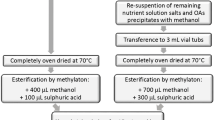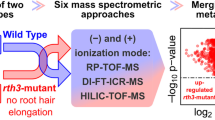Abstract
A sensitive method for quantification of citric, fumaric, malic, malonic, oxalic, trans aconitic, and succinic acid in soil- and root-related samples is presented. The method is based on a novel, fast, and simple esterification procedure and subsequent analysis via liquid chromatography–mass spectrometry. Derivatization comprises in situ generation of HCl, which catalyzes the Fischer esterification with benzyl alcohol. As a key advance, the esterification with the aromate allows reversed-phase separation and improves electrospray ionization efficiency. The method provided procedural detection limits of 1 nM for citric, 47 nM for fumaric, 10 nM for malic, 10 nM for malonic, 16 nM for oxalic, 15 nM for succinic, and 2 nM for aconitic acid utilizing 500 μL of liquid sample. The working range was 3 nM to 10 μM for citric acid, 158 nM to 10 μM for fumaric acid, 34 nM to 10 μM for malic acid, 33 nM to 10 μM for malonic acid, 53 nM to 10 μM for oxalic acid, 48 nM to 10 μM for succinic acid, and 6 nM to 10 μM for aconitic acid. Quantification of the analytes in soil-related samples was performed via external calibration of the entire procedure utilizing 13C-labeled oxalic and citric acid as internal standards. The robustness of the method was tested with soil extracts and samples from hydroponic experiments. The latter concerned the regulation of phosphorus solubilization via plant root exudation of citric, malic, and oxalic acid.





Similar content being viewed by others
References
Oburger E, Kirk GJD, Wenzel WW, Puschenreiter M, Jones DL (2009) Interactive effects of organic acids in the rhizosphere. Soil Biol Biochem 41(3):449–457
Jones DL, Dennis PG, Owen AG, Van Hees PAW (2003) Organic acid behavior in soils—misconceptions and knowledge gaps. Plant Soil 248(1–2):31–41
Uren NC (2007) Types, amounts and possible functions of compounds released into the rhizosphere by soil grown plants. In: Pinton R, Varanini Z, Nannipieri P (eds) The rhizosphere: biochemistry and organic substances at the soil–plant interface, 2nd edn. CRC, Boca Raton
Neumann G, Römheld V (2007) The release of root exudates as affected by the plant physiological status. In: Pinton R, Varanini Z, Nannipieri P (eds) The rhizosphere: biochemistry and organic substances at the soil–plant interface, 2nd edn. CRC, Boca Raton
Jones DL, Darrah PR (1994) Role of root derived organic acids in the mobilization of nutrients from the rhizosphere. Plant Soil 166(2):247–257
Gerke J, Beißner L, Römer W (2000) The quantitative effect of chemical phosphate mobilization by carboxylate anions on P uptake by a single root. I. The basic concept and determination of soil parameters. J Plant Nutr Soil Sci 163(2):207–212
Jones DL, Eldhuset T, De Wit HA, Swensen B (2001) Aluminium effects on organic acid mineralization in a Norway spruce forest soil. Soil Biol Biochem 33(9):1259–1267
Ström L, Owen AG, Godbold DL, Jones DL (2005) Organic acid behaviour in a calcareous soil implications for rhizosphere nutrient cycling. Soil Biol Biochem 37(11):2046–2054
Puschenreiter M, Wenzel WW, Wieshammer G, Fitz WJ, Wieczorek S, Kanitsar K, Köllensperger G (2005) Novel micro-suction-cup design for sampling soil solution at defined distances from roots. J Plant Nutr Soil Sci 168(3):386–391
Tsai YI, Hsieh L, Weng T, Ma Y, Kuo S (2008) A novel method for determination of low molecular weight dicarboxylic acids in background atmospheric aerosol using ion chromatography. Anal Chim Acta 626(1):78–88
Strobel BW (2001) Influence of vegetation on low-molecular-weight carboxylic acids in soil solution—a review. Geoderma 99(3–4):169–198
Yang L, Yu LE (2008) Measurements of oxalic acid, oxalates, malonic acid, and malonates in atmospheric particulates. Environ Sci Technol 42(24):9268–9275
Kakola J, Alen R (2006) A fast method for determining low-molecular-mass aliphatic carboxylic acids by high-performance liquid chromatography–atmospheric pressure chemical ionization mass spectrometry. J Sep Sci 29(13):1996–2003
Nisperos-Carriedo MO, Buslig BS, Shaw PE (1992) Simultaneous detection of dehydroascorbic, ascorbic, and some organic acids in fruits and vegetables by HPLC. J Agric Food Chem 40(7):1127–113
Ohkawa H (1985) Gas chromatographic determination of oxalic acid in foods. J Assoc Off Anal Chem 68(1):108–111
Holmes RP, Kennedy M (2000) Estimation of the oxalate content of foods and daily oxalate intake. Kidney Int 57(4):1662–1667
Dabek-Zlotorzynska E, Piechowski M, McGrath M, Lai EPC (2001) Determination of low-molecular-mass carboxylic acids in atmospheric aerosol and vehicle emission samples by capillary electrophoresis. J Chromatogr A 910(2):331–345
Klampfl CW (2007) Determination of organic acids by CE and CEC methods. Electrophoresis 28(19):3362–3378
Kenney BF (1991) Determination of organic acids in food samples by capillary electrophoresis. J Chromatogr 546:423
Galli V, Barbas C (2004) Capillary electrophoresis for the analysis of short-chain organic acids in coffee. J Chromatogr A 1032(1–2):299–304
Klampfl CW, Katzmayr MU (1998) Determination of low-molecular-mass anionic compounds in beverage samples using capillary zone electrophoresis with simultaneous indirect ultraviolet and conductivity detection. J Chromatogr A 822(1):117–123
Garcia A, Olmo B, Lopez-Gonzalvez A, Cornejo L, Rupérez FJ, Barbas C (2008) Capillary electrophoresis for short chain organic acids in faeces. Reference values in a Mediterranean elderly population. J Pharm Biomed Anal 46(2):356–361
Hagberg J (2003) Analysis of low-molecular-mass organic acids using capillary zone electrophoresis–electrospray ionization mass spectrometry. J Chromatogr A 988:127–133
Ross KL, Tu TT, Smith S, Dalluge JJ (2007) Profiling of organic acids during fermentation by ultraperformance liquid chromatography–tandem mass spectrometry. Anal Chem 79(13):4840–4844
Chen Z, Kim KR, Owens G, Naidu R (2008) Determination of carboxylic acids from plant root exudates by ion exclusion chromatography with ESI–MS. Chromatographia 67(1–2):113–117
Bylund D, Norström SH, Essén SA, Lundström US (2007) Analysis of low molecular mass organic acids in natural waters by ion exclusion chromatography tandem mass spectrometry. J Chromatogr A 1176(1–2):89–93
Langner HJ (1965) Gaschromatographische Trennung und Bestimmung der Milchsäure als Methylester an Golay-Säulen. Mitteilung aus dem Institut für Lebensmittelhygiene der Freien Universität Berlin 129(1):25–26
Maurer HH, Arlt JW (1998) Detection of 4-hydroxycoumarin anticoagulants and their metabolites in urine as part of a systematic toxicological analysis procedure for acidic drugs and poisons by gas chromatography–mass spectrometry after extractive methylation. J Chromatogr B Biomed Appl 714(2):181–195
Nakao R, Oka K, Fukumoto T (1981) Simple method for the esterification of carboxylic acids using chlorosilanes. Bull Chem Soc Jpn 54:1267–1268
van Hees PAW, Johansson E, Jones DL (2008) Dynamics of simple carbon compounds in two forest soils as revealed by soil solution concentrations and biodegradation kinetics. Plant Soil 310:11–23
Jones DL (1998) Organic acids in the rhizosphere—a critical review. Plant Soil 205:25–44
Acknowledgement
We are grateful for financial support from the Austrian Science Fund (Project P20069-B16).
Author information
Authors and Affiliations
Corresponding author
Additional information
Published in the special issue Analytical Sciences in Austria with guest editors G. Allmaier, W. Buchberger, and K. Francesconi.
Rights and permissions
About this article
Cite this article
Jaitz, L., Mueller, B., Koellensperger, G. et al. LC–MS analysis of low molecular weight organic acids derived from root exudation. Anal Bioanal Chem 400, 2587–2596 (2011). https://doi.org/10.1007/s00216-010-4090-0
Received:
Revised:
Accepted:
Published:
Issue Date:
DOI: https://doi.org/10.1007/s00216-010-4090-0




